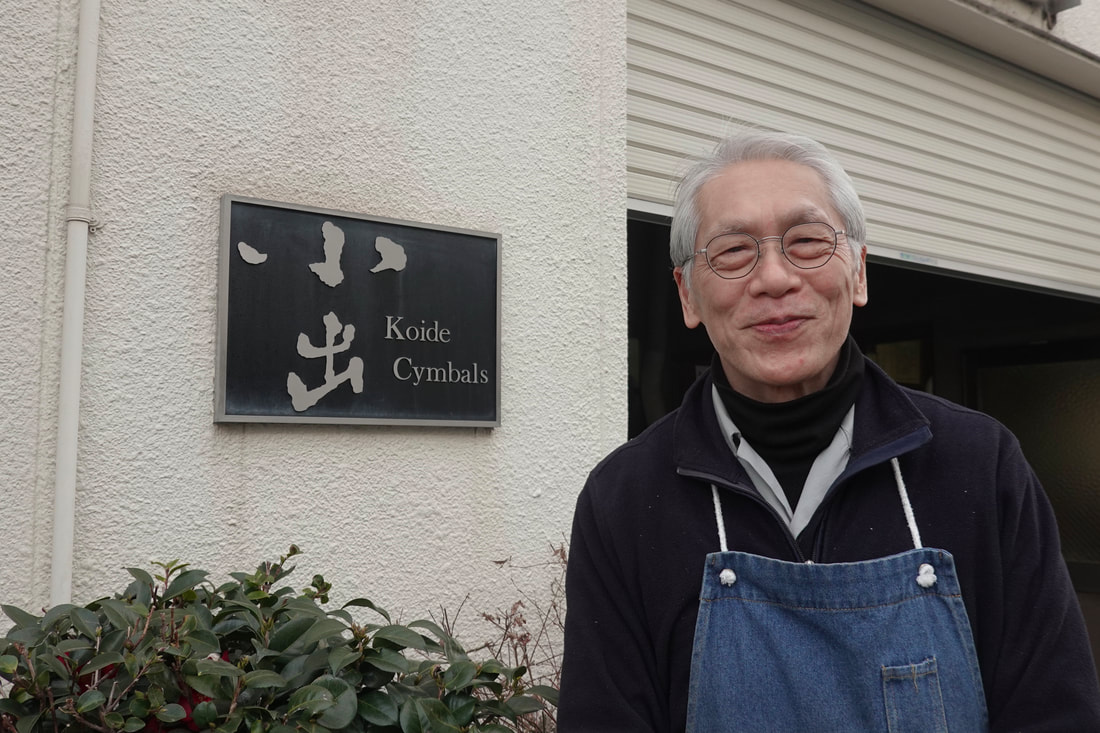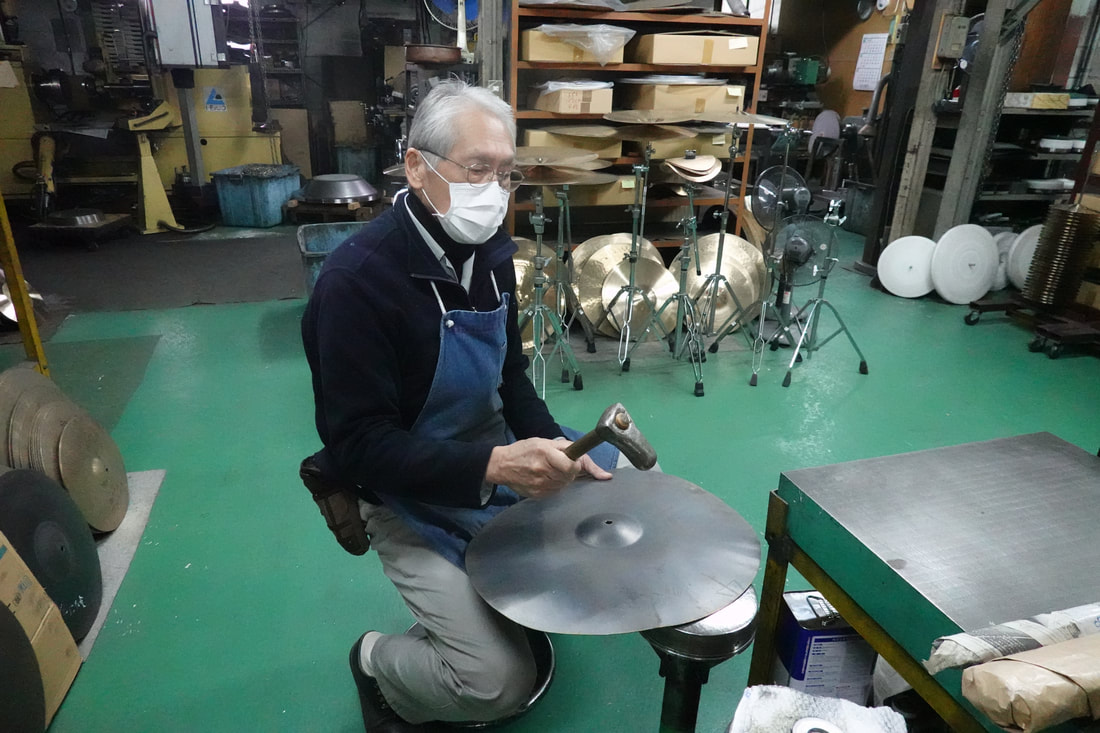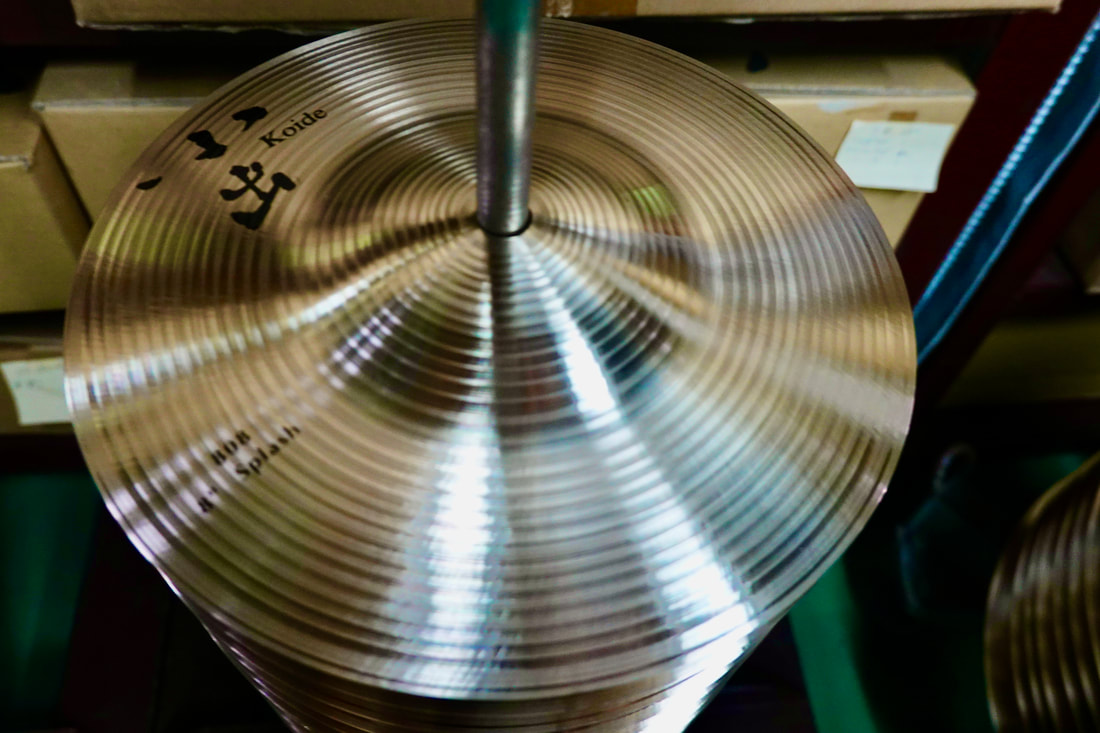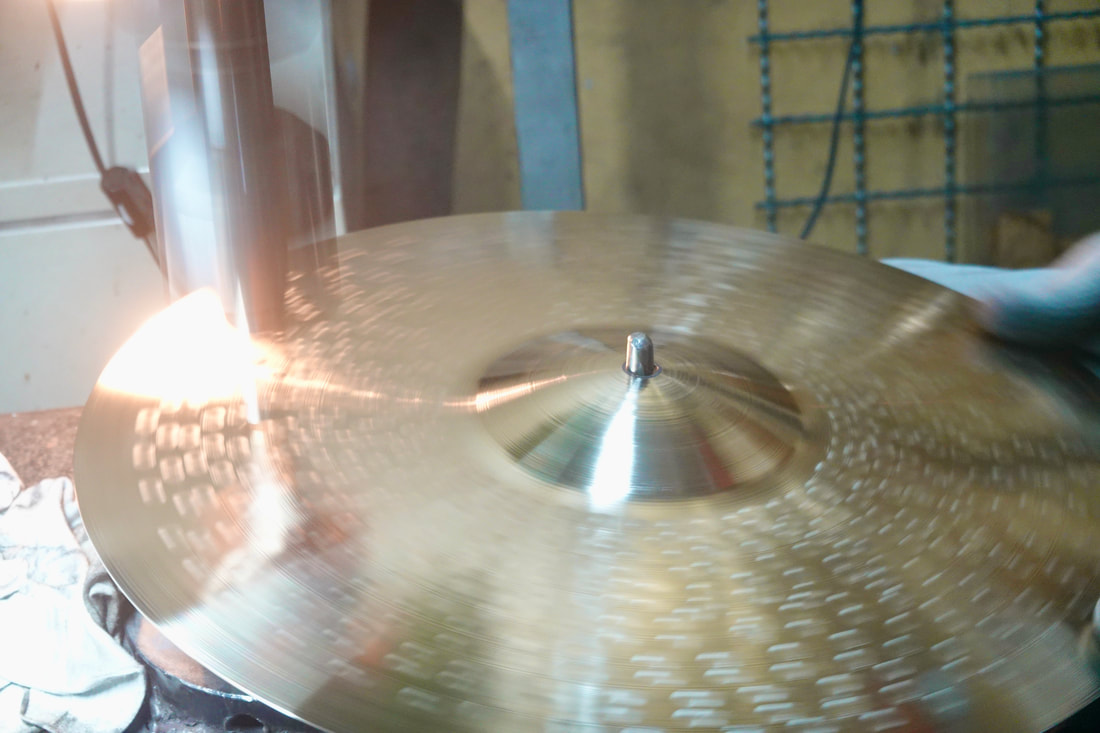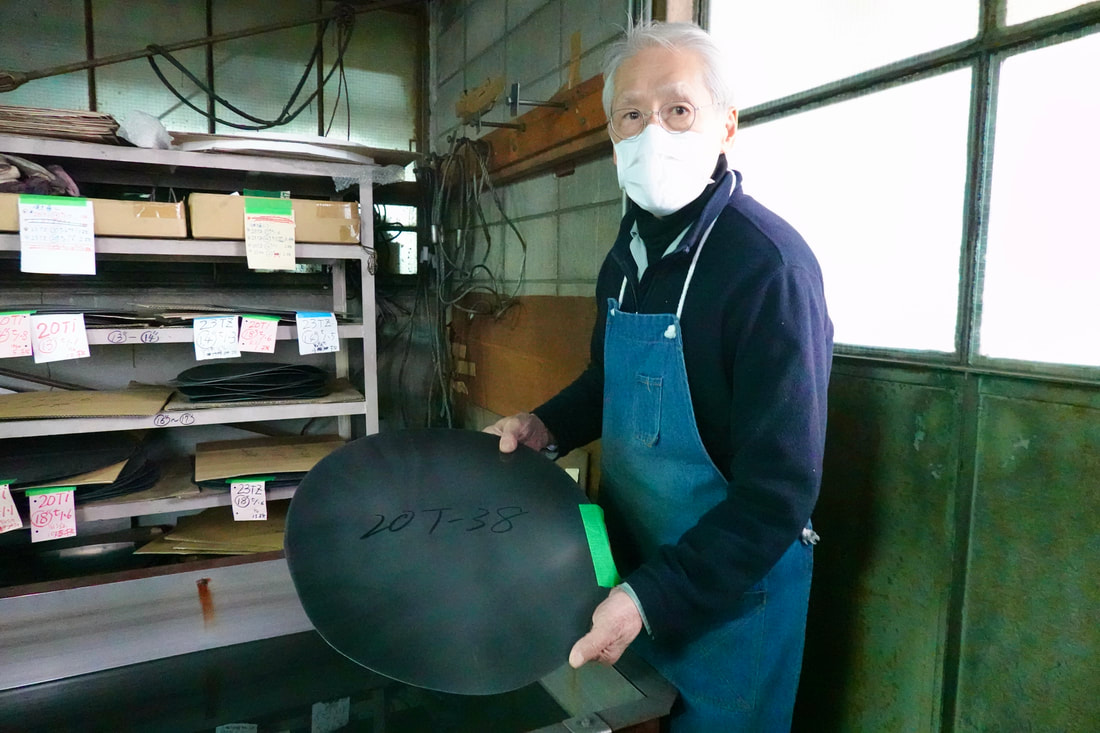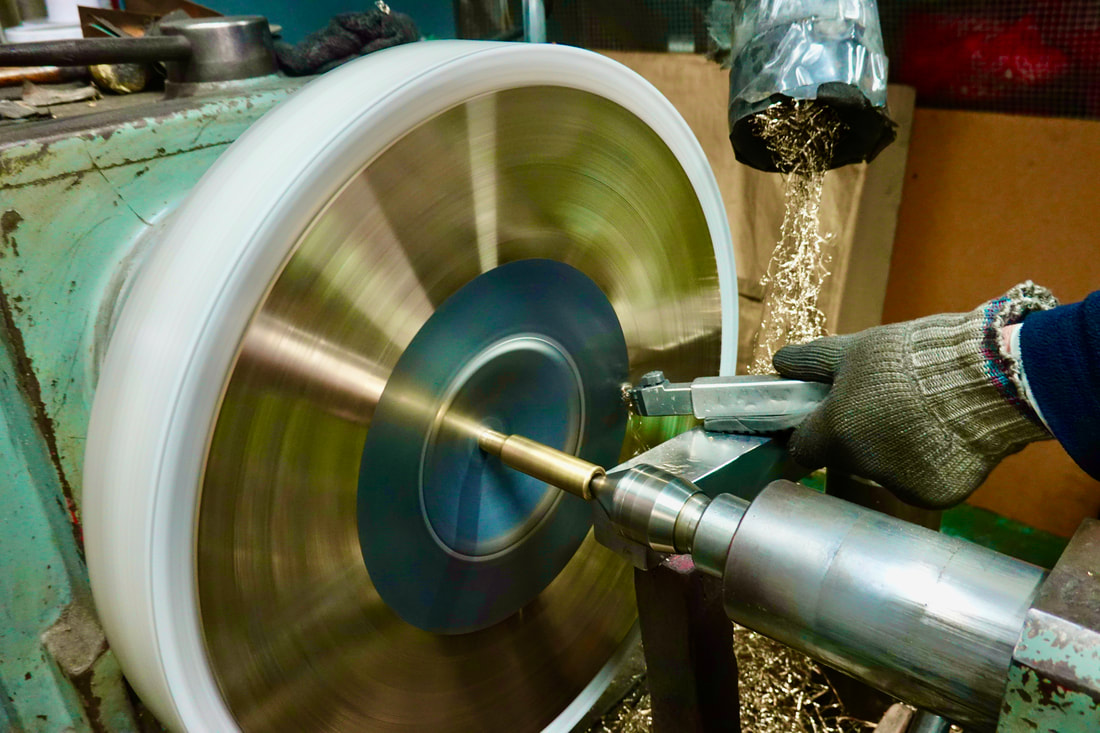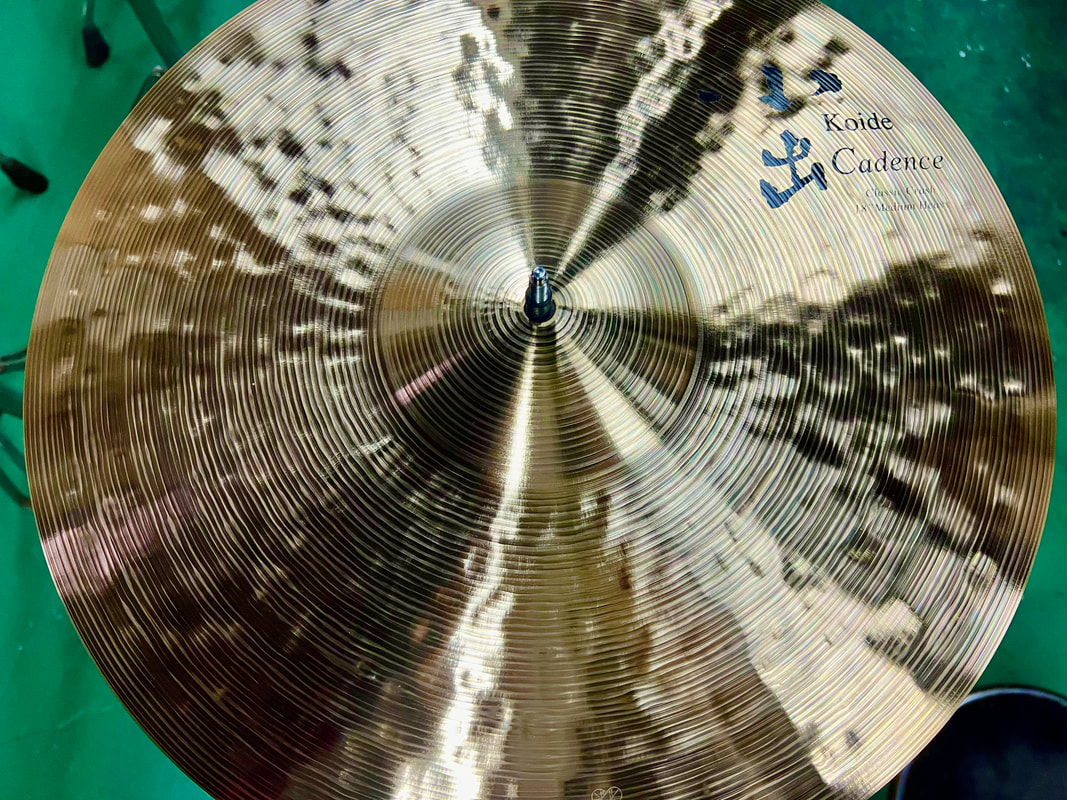Toshio Koide
The journey to make the world's finest cymbals
Toshio Koide is the president of Koide Co., Ltd, the only cymbal manufacturer in Japan. For more than 20 years, he has worked tirelessly to produce the finest cymbals in the world, giving up his days off and even sleeping and dreaming about it, to create the cymbals that he is now so proud of. When you open the factory’s old sliding glass door, you will be greeted by many cymbals with their polished golden surfaces shining brightly and gloriously. From a small room in the factory, you can hear the sound of young, handsome employees carefully hammering cymbals on a machine.
|
Toshio Koide, the president
|
It makes me really happy when I hit them and they sound good!The project to develop and create a good sounding cymbal from scratch in Japan started when his young drummer employee got fascinated with the factory’s history of the manufacturing experience of brass cymbals in the 1960s. Making cymbals is a craftsman's job, using specially developed metal materials for cymbals, and hammering them by hand or machine until they create beautiful sounds. Along the way, an unexpected offer from a Japanese alloy company during the development process gave them a boost to develop a new material for cymbals, which led to joint research on creating a material exclusive for cymbals that is unparalleled anywhere in the world, and now they can produce a series of products with a satisfying and beautiful sound.
”It makes me really happy when I hit them and they sound good!" says Mr. Koide with a boyish gleam in his eyes, expressing his passion for craftsmanship. |
Koide Co., Ltd., how it started...
|
Koide Co., Ltd. was founded in 1947, shortly after the end of World War II. Mr. Koide's father started this metalworking company with his two brothers based on his experience working in a metalworking factory after graduating from elementary school and serving as a mechanic at the Japan 3rd Air Fleet Headquarters in Tenri City, Nara Prefecture during the war. As people had to donate their daily metal goods due to the government's metal provision during the war, everyone bought their pots and kettles like crazy as soon as they were made.
The business took off, and in 1955 the plant was moved to Kami, Hirano-ku, Osaka. The company has continued metalworking in the same location ever since. |
Mr. Koide hammering a cymbal
|
Toshio Koide, the current president, was born in 1949 as the only child in the Koide family. In those days, it was commonplace to make one's own toys to play with, and Mr. Koide loved making things from an early age. He made models of tanks and other vehicles by assembling small pieces of wood, and he also made wooden slingshots with rubber to shoot objects. As for sports, he grew up playing baseball with a group of neighborhood kids. He was an all-rounder who could play any position.
After graduating from high school in Osaka, he enrolled in Hosei University in Tokyo with a business administration major. He enjoyed life in the big city of Tokyo, away from his parents for the first time in his life. Mr. Koide had been helping out at the factory since he was a student, so he felt right at home and decided to become the successor of the business. His father was very pleased when he told him that he wanted to be the successor. After graduation, Mr. Koide spent about three months training at the factory of Leifeld Metal Spinning GmbH, a German metal spinning machine company in Ahlen, a city in northeastern Germany, in the early 1970s. Metal spinning is a spinning process in which a round, flat metal sheet is gradually transformed by pressing a rod called a spatula on the metal sheet while it rotates. As his company specialized in manufacturing round metal objects using this company's machinery, this training was very useful for him.
However, factories in Germany close for one month for summer vacation. So he took advantage of that time to become a backpacker, which was popular at the time, and traveled to England, Ireland, France, Italy, Greece, and Egypt to see the world. Some of his most memorable experiences were staying in Scotland, where he was forced to sleep in the open air because all of the hotels were full and it was too cold to sleep even though it was in the middle of the summer.
Ever since, he has been engaged in the processing of various metal parts at the company. Just as the kettles used to cook rice have changed over time to electric rice cookers, so have the products he makes. He has made various parts for starting from commercial washing machines, mechanical parts for x-ray machines, to reflectors for lighting. And he kept shifting to new and specialized products that other companies cannot make so that he did not have to compete for processing fees.
After graduating from high school in Osaka, he enrolled in Hosei University in Tokyo with a business administration major. He enjoyed life in the big city of Tokyo, away from his parents for the first time in his life. Mr. Koide had been helping out at the factory since he was a student, so he felt right at home and decided to become the successor of the business. His father was very pleased when he told him that he wanted to be the successor. After graduation, Mr. Koide spent about three months training at the factory of Leifeld Metal Spinning GmbH, a German metal spinning machine company in Ahlen, a city in northeastern Germany, in the early 1970s. Metal spinning is a spinning process in which a round, flat metal sheet is gradually transformed by pressing a rod called a spatula on the metal sheet while it rotates. As his company specialized in manufacturing round metal objects using this company's machinery, this training was very useful for him.
However, factories in Germany close for one month for summer vacation. So he took advantage of that time to become a backpacker, which was popular at the time, and traveled to England, Ireland, France, Italy, Greece, and Egypt to see the world. Some of his most memorable experiences were staying in Scotland, where he was forced to sleep in the open air because all of the hotels were full and it was too cold to sleep even though it was in the middle of the summer.
Ever since, he has been engaged in the processing of various metal parts at the company. Just as the kettles used to cook rice have changed over time to electric rice cookers, so have the products he makes. He has made various parts for starting from commercial washing machines, mechanical parts for x-ray machines, to reflectors for lighting. And he kept shifting to new and specialized products that other companies cannot make so that he did not have to compete for processing fees.
Cymbals made in brass back in 1960s
|
In 2003, Koide Works Ltd. began making cymbals in full scale, and he named his cymbal making division Koide Cymbals.
The company’s cymbal production dates back to the late 1960s, as mentioned above. The skyrocketing music boom in Japan led to an increase in the number of people purchasing musical instruments, and the company was approached by a musical instrument manufacturer called Sakae Rhythm Musical Instruments (currently KORG) in Osaka about manufacturing cymbals made of brass. Although brass had the disadvantage of being easily bent by impact, it was easy to process and, above all, inexpensive, making it suitable for beginners. |
cymbals
|
They made a lot of cymbals, but at that time, Japanese manufacturing was at its peak, and they could no longer produce cymbals because they were too busy with their main metalworking business. Due to the growing popularity of self printing photographs, the production of enlargers for enlarging and projecting images from negative film to burn onto photographic paper became overwhelmingly demanding. After this was settled, from 1979 to 2002, at the request of the same Sakae Rhythm Instruments, they made copper body parts for timpani’s used in orchestras and other musical groups.
They made a lot of cymbals, but at that time, Japanese manufacturing was at its peak, and they could no longer produce cymbals because they were too busy with their main metalworking business. Due to the growing popularity of self printing photographs, the production of enlargers for enlarging and projecting images from negative film to burn onto photographic paper became overwhelmingly demanding. After this was settled, from 1979 to 2002, at the request of the same Sakae Rhythm Instruments, they made copper body parts for timpani’s used in orchestras and other musical groups.
They made a lot of cymbals, but at that time, Japanese manufacturing was at its peak, and they could no longer produce cymbals because they were too busy with their main metalworking business. Due to the growing popularity of self printing photographs, the production of enlargers for enlarging and projecting images from negative film to burn onto photographic paper became overwhelmingly demanding. After this was settled, from 1979 to 2002, at the request of the same Sakae Rhythm Instruments, they made copper body parts for timpani’s used in orchestras and other musical groups.
Paragraph.
They made a lot of cymbals, but at that time, Japanese manufacturing was at its peak, and they could no longer produce cymbals because they were too busy with their main metalworking business. Due to the growing popularity of self printing photographs, the production of enlargers for enlarging and projecting images from negative film to burn onto photographic paper became overwhelmingly demanding. After this was settled, from 1979 to 2002, at the request of the same Sakae Rhythm Instruments, they made copper body parts for timpani’s used in orchestras and other musical groups.
They made a lot of cymbals, but at that time, Japanese manufacturing was at its peak, and they could no longer produce cymbals because they were too busy with their main metalworking business. Due to the growing popularity of self printing photographs, the production of enlargers for enlarging and projecting images from negative film to burn onto photographic paper became overwhelmingly demanding. After this was settled, from 1979 to 2002, at the request of the same Sakae Rhythm Instruments, they made copper body parts for timpani’s used in orchestras and other musical groups.
Paragraph.
What is a cymbal?
|
A drum set & cymbals
|
Cymbals are musical instruments that produce sound by hitting a metal plate in the shape of a brimmed hat that has been stretched relatively thin. Its roots can be traced back to Western Asia some 3,000 years ago and later spread to Europe, Asia, and North Africa, and it was used by the Turkish military before the 14th century. In European music, cymbals were used since the 17th century, but most notably in the 19th century when composers began to use cymbals extensively to meet their needs. The evolution of the instrument has been a long time coming. Today, cymbals with roots in 16th century Turkey are the most common, and are widely seen paired with a drum set, as well as suspended cymbals used in orchestras and brass bands. (Reference: Wikipedia)
|
The Koide Cymbals Project begins
|
Koide Cymbals began with an analysis of cymbal materials. He bought many cymbals from major manufacturers around the world and analyzed them with the help of his cousin, who was a copper expert working for a major metal company.
As a result, he found out that it was mostly an alloy of copper and tin with a little silver, and since such materials were not available in Japan, he searched for them and finally found them in Germany and Turkey, and imported them. He then brought his finished product to a drum retailer in Osaka who agreed to sell them. That was in 2003. A website was also created, and a percussion specialty retailer in Tokyo started selling their products, gradually increasing domestic demands. One day in 2007, he received a phone call. It was from a company in Fukui Prefecture called Osaka Alloy Industries. The company boasts a large share of the Japanese market for phosphorus-copper alloys and manufactures special copper alloys such as superconductive materials used in medical machines like MRIs. At the time, they were exploring the possibility of applying their new technology they had developed for superconductive materials in other fields. Since cymbal materials are very similar to superconductive materials, one of their employees, who was a music lover, contacted them after seeing their website. |
hammering cymbal machine
|
Developing special metal material designated for cymbals
|
This was an unexpected offer that made Mr. Koide thrilled.
Until then, the materials they were using were imported materials that weren’t the most reliable and would cause cracking problems during processing. Also, since the materials were the same as those used by overseas cymbal manufacturers, it was difficult to differentiate their products from their overseas counterparts, even though they had worked hard to produce them. It was truly a lifesaver! Soon after, joint research began, and it took about two years of numerous experiments to develop a production method for cymbal planks. Their goal was to develop new cymbal materials without being bound by traditional materials, to improve durability, and to develop materials that would produce a unique sound different from competitors' products. |
Special metal alloy made just for Koide Cymbals
|
In 2010, trial production of cymbals using materials developed by Osaka Alloy Industries began in full swing. Thereafter, Osaka Alloy Industries has continued to develop advanced alloys through joint research with the University of Fukui and the Industrial Technology Center of Fukui Prefecture, as well as through measurements using specialized equipment.
Cymbal material contains high concentrations of tin, and in the course of the research, it was found that as the percentage of tin increases, the tone becomes clearer and more brilliant. However, the more tin in the material, the more difficult to shape. Therefore, research was conducted to increase the strength of the alloy by adding zirconium, titanium, and iron to make it less susceptible to cracking and easier to process. It may sound easy to say, but in fact, it was a hard road. To reach this point, they made more than 100 prototypes. Mr. Koide and his team then patiently continued to create cymbals using one trial material after another and tested them out.
Cymbal material contains high concentrations of tin, and in the course of the research, it was found that as the percentage of tin increases, the tone becomes clearer and more brilliant. However, the more tin in the material, the more difficult to shape. Therefore, research was conducted to increase the strength of the alloy by adding zirconium, titanium, and iron to make it less susceptible to cracking and easier to process. It may sound easy to say, but in fact, it was a hard road. To reach this point, they made more than 100 prototypes. Mr. Koide and his team then patiently continued to create cymbals using one trial material after another and tested them out.
Ongoing cymbal manufacturing process improvements
|
The process of creating cymbal material that suppresses the sustain of sound (fast sound decay) so that sounds do not overlap was initially a process of continuous experimentation, relying on auditory skills. Later, with the help of large-scale measuring equipment, it became possible to make cymbals that sounded well with a slow sound decay as well as cymbals with a fast sound decay. At present, they provide four different types of cymbal materials, allowing Koide Cymbal to make cymbals for different purposes. As a result, this joint research won the Small and Medium Enterprise Agency Director-General's Award at the Japan Local Invention Awards in 2019, and a new material was developed for cymbal manufacturing that is unique in the world.
While material development progressed, Koide Manufacturing continued to improve its manufacturing process. Cymbal manufacturing is a highly manual and patient process. The base metal is beaten and stretched with a hammer by machine and by hand to create thin cymbals with good sound quality. Once they are hammered and shaped, they are left to rest for about a week. Then, a detailed work procedure was established in which the sound quality was checked by pounding here and there, and adjustments were made as they were pounded. |
Making fine grooves on the cymbal
|
Because they are products made by hand, each cymbal is unique. The cymbals in the series are now accustomed to sounding alike by ear, but to reach this point, they went through a long and tedious trial-and-error process of detailed adjustment. Thanks to this, they are now able to produce consistent and similar sound quality as a series, even though each cymbal has a slightly different and unique tone. Currently, they make four different sound quality cymbal series: Absolute, Brilliant, and Cadence. The latest Cadence series cymbals have clear and crisp sound with less sustain. The Sensitive Series for suspended cymbals used in brass bands are designed to produce a clean sound even for those who do not have much experience with cymbals. All of them are made from materials backed by advanced technology that other companies do not use, so they can create unique tones to contribute to expanding the possibilities of music in the future as well. In addition to that, Mr. Koide believes that the clear tone of these cymbals can also be used for healing.
Cymbals that excite both makers and players
|
What Mr. Koide would like to do in the future is to promote Koide cymbals, a product that is the result of the accumulated efforts of many people.
Currently, the monthly production is still around 200-300 pieces, but with the help of many people, the sales channels have gradually expanded, and a distributor has been established in the United States as well. In the near future, they would like to exhibit their cymbals at some international musical instrument shows in the U.S. to raise awareness of their products and make them available to more people around the world. In addition, many of Japan's recent local factories are struggling to find successors, but Koide Seisakusho has three enthusiastic young workers with a strong work ethic who have been with the company for a long time. Mr. Koide is motivated to further develop sales channels for them and for the next generation, and to make cymbals that excite both those who make them and those who play them. |
Koide Cymbal
|
Koide Co., Ltd.
1-22-32, Kami-shokakuji, Hirano-ku, Osaka, 547-0006, Japan
President Toshio Koide
TEL (06)6791-1824
FAX (06)6791-0128
e-mail info@koide-web.co.jp
Koide Co., Ltd. Website: http://www.koide-web.co.jp
Koide Cymbals Website: http://koidecymbal.com
Photo & script by Yuki Maguire
|
threetreerecords@gmail.com
Telephone901-825-8127
|

